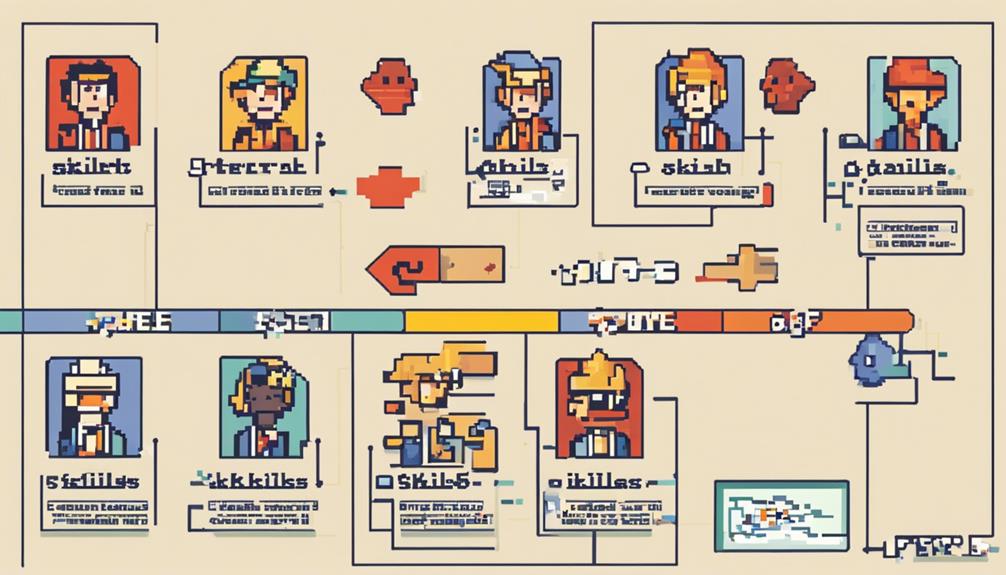To improve, set clear goals and realistic expectations. Identify skills needed, strengths, and weaknesses to create an action plan. Break goals into manageable steps, use available resources, and anticipate challenges. Regularly review and adjust your plan for progress. Take online courses and join virtual events for continuous learning. Assess achievements, identify areas for improvement, and make necessary adjustments. Stay accountable and track progress to boost motivation. By following these practical steps, you can effectively work towards self-improvement and personal growth.
Key Takeaways
- Identify specific areas for improvement based on self-assessment.
- Set achievable goals with clear timelines for progress tracking.
- Research and utilize online resources for skill development.
- Create a detailed action plan with manageable steps.
- Regularly evaluate and adjust the plan to stay on track.
Define Results and Motivation
To kickstart your growth journey effectively, begin by clearly defining the personal development goals you aim to achieve and the motivations that fuel your aspirations. Setting specific outcomes for self-improvement is essential as it provides a clear direction and helps you measure progress along the way.
By understanding what you want to achieve, you can establish realistic goals that keep you focused and motivated.
Motivation is a key factor in driving action towards growth. Identifying what inspires and energizes you can help you stay committed to your personal development goals, even when faced with challenges.
Linking your aspirations to tangible results not only enhances your dedication but also provides a sense of purpose and fulfillment as you progress on your journey.
Determine Required Skills

Identify the skills necessary for achieving your personal development goals by evaluating your current capabilities and recognizing areas where improvement is needed. To create an effective personal development plan, start by listing the skills required to reach your desired outcomes. Consider both technical skills, like project management or coding, and soft skills, such as communication or time management.
Reflect on your strengths and weaknesses honestly to pinpoint areas where growth is essential for progress. Once you have a clear understanding of the skills needed, you can tailor your personal development plan to focus on enhancing these specific areas. Whether it's through formal education, online courses, mentorship, or practical experience, there are various ways to acquire new skills and improve existing ones.
Perform Skills Self-assessment

Evaluating your current skill levels is vital to understanding where you excel and where you can improve. By appraising your proficiency in key competencies, you can pinpoint areas that are important for your personal and professional growth.
Utilizing self-evaluation tools or surveys can provide valuable insights into your strengths and weaknesses.
Self-Assessment Importance
Performing a skills self-evaluation is vital for understanding your current skillset and areas requiring improvement. By engaging in self-evaluation, you can pinpoint your strengths and weaknesses, gaining a clear picture of where you stand and what areas require enhancement.
This process is essential in selecting the most relevant skills to focus on for personal growth. Additionally, self-evaluation enables you to create targeted action plans that address the identified skill gaps efficiently.
Regularly assessing your skills not only helps in tracking your progress but also allows for adapting and refining your strategies for self-improvement as needed. Embracing self-evaluation as a fundamental step in your growth journey empowers you to make informed decisions about where to direct your efforts, ultimately leading to continuous development and advancement in your skillset.
Skill Evaluation Strategies
Conducting a thorough self-evaluation of your skills is vital for mapping out your growth trajectory effectively. Performing a self-analysis allows you to pinpoint your strengths and areas needing improvement.
By evaluating your existing skills against your desired goals and objectives, you can identify where you stand and what you need to work on. Utilizing tools like competency frameworks or self-evaluation surveys can provide a structured approach to this evaluation process.
Assessing your proficiency levels, relevance to goals, and potential skill gaps will give you a clear understanding of where you currently stand. This clarity enables you to tailor your development plans effectively, focusing on enhancing the skills that are most important for your growth.
Embrace self-analysis as a valuable tool for self-improvement, allowing you to make informed decisions about your skill development and progress towards your objectives.
Isolate One Skill

To maximize your growth potential, pinpointing a specific skill for further development is essential. By isolating one skill, you can focus your efforts and resources effectively, leading to efficient progress. It allows for better tracking and measurement of your advancement, enhancing your ability to master that particular area. To assist you in this process, here is a table outlining steps to create a personal development plan:
| Steps to Create a Personal Development Plan |
|---|
| Identify the skill you want to improve |
| Set specific goals for skill enhancement |
| Research resources for skill development |
| Create a timeline for achieving your goals |
| Evaluate and adjust your plan regularly |
Develop an Action Plan

Craft a detailed action plan for your personal growth by setting specific, measurable goals. Begin by identifying what you want to achieve and why it's important to you.
Break down your personal goal into smaller, manageable steps that you can work on consistently. Consider the resources and support networks available to you that can help you along the way. Anticipate potential obstacles and brainstorm strategies to overcome them. Set realistic time frames for each action to keep yourself accountable and motivated.
Regularly review your action plan to track your progress and make any necessary adjustments. Celebrate small wins along the way to stay motivated and encouraged.
Set SMART Goals

Start by defining Specific, Measurable, Achievable, Relevant, and Time-bound goals to pave the way for your personal growth journey.
Setting SMART goals is a powerful strategy to propel your self-improvement efforts forward. These goals are designed to be clear and well-defined, allowing you to track your progress effectively and maintain your motivation throughout the process.
By incorporating the SMART criteria into your goal-setting process, you enhance your accountability and focus on the most critical areas for your development. This approach enables you to prioritize tasks efficiently and work towards achieving realistic targets.
SMART goals provide a structured framework for success, helping you monitor your achievements and make any necessary adjustments to your strategies. Embracing SMART goal-setting in your action plan for growth sets you on a path towards continuous improvement in your personal development journey.
Seek Mentorship and Networking

In your pursuit of personal growth, seeking mentorship and expanding your professional network can greatly enhance your career opportunities and development. Mentorship has been shown to lead to a 3.9x increase in career advancement opportunities and boost employee retention rates by up to 25%. Additionally, 76% of professionals believe mentorship is vital for career success.
On the other hand, networking plays a pivotal role too, with a 70% chance of landing a job through referrals. Building a diverse network can increase creativity and innovation by 85%.
By actively engaging in mentorship programs and expanding your network, you open doors to new possibilities and experiences. Look for mentors who inspire you and can provide valuable guidance based on their experiences. Similarly, networking allows you to connect with a wide range of professionals who can offer support, advice, and potential career opportunities.
Embrace mentorship and networking as essential tools in your journey towards personal and professional growth.
Continuous Learning Opportunities

Explore diverse avenues for ongoing learning to enhance your knowledge and skills effectively. To develop a detailed professional development plan, consider the following opportunities:
| Learning Avenue | Description |
|---|---|
| Online Courses | Access a wide range of courses on platforms like Coursera, Udemy, and LinkedIn Learning to acquire new skills and knowledge. |
| Webinars, Workshops, Conferences | Join virtual events to broaden your understanding of various topics and interact with experts in your field. |
| Industry-Specific Events and Forums | Stay up-to-date on industry trends and advancements by participating in relevant events and engaging with peers in specialized forums. |
| Online Communities and Social Platforms | Network with professionals, share insights, and stay connected with industry developments by joining online groups and utilizing social media platforms. |
Evaluate Progress Regularly

Regularly reviewing your progress is vital for staying on track towards your goals and making informed adjustments as needed. Here are four key reasons why evaluating progress regularly is important for your personal growth journey:
- Tracking Achievements: By assessing your progress regularly, you can celebrate your accomplishments and see how far you've come, which can boost your motivation.
- Identifying Areas for Improvement: Monitoring your progress allows you to pinpoint areas where you may need to put in more effort or seek additional support to enhance your growth.
- Making Informed Adjustments: Reviewing progress regularly enables you to adapt your action plan based on what's working well and what may need to be changed to optimize your success.
- Maintaining Accountability: Regular evaluation fosters a sense of responsibility towards your growth journey, ensuring that you remain committed to your goals and take ownership of your development.
Create a Personal Growth Strategy

Crafting a personal growth strategy involves setting clear goals in various aspects of your life, such as career, relationships, finance, and health.
By outlining actionable plans that align with your goals, you can effectively track your progress and make necessary adjustments.
Utilize tools like the Tony Robbins Wheel of Life Assessment to identify areas for improvement and prioritize growth opportunities.
Setting Clear Goals
To kickstart your personal growth journey, begin by establishing clear and SMART goals in your personal growth strategy. Setting clear goals is essential for mapping out your path to personal development.
Here are four key steps to help you set clear goals effectively:
- Reflect on Your Values and Priorities: Take a moment to contemplate what truly matters to you and align your goals with these values. This will give your goals meaning and purpose.
- Make Your Goals Specific and Measurable: Define your goals in clear and precise terms. Make sure they're measurable so that you can track your progress and know when you've achieved them.
- Ensure Your Goals Are Achievable and Relevant: Set goals that are realistic and within your reach. They should also be relevant to your personal growth journey and aspirations.
- Set a Time Frame for Your Goals: Establish deadlines for your goals to create a sense of urgency and keep yourself accountable. Time-bound goals help you stay focused and motivated on your growth path.
Crafting Action Plans
Crafting an effective personal growth strategy involves setting specific, measurable, and achievable goals that align with your personal development objectives. Identify key areas for improvement and break down larger goals into smaller, manageable tasks within your action plan.
Establish realistic time frames for each task to hold yourself accountable and make steady progress. A detailed action plan is crucial for implementing self-improvement techniques effectively and achieving desired outcomes. This plan serves as your roadmap for personal development, guiding you through the necessary steps to reach your goals.
Stay focused, committed, and watch as your carefully crafted action plan propels you towards self-improvement and success.
Tracking Progress
Monitoring your progress is essential for evaluating the effectiveness of your personal growth strategy. Tracking progress allows you to measure your achievements, identify setbacks, and make necessary adjustments to stay on course.
Here are four practical tips to help you effectively track your progress:
- Set Clear Goals: Define specific, measurable objectives to track your progress accurately.
- Establish Deadlines: Setting deadlines for your goals creates a sense of urgency, driving motivation and maintaining focus.
- Regular Reflection: Reflect on your progress frequently to stay accountable and motivated towards your growth.
- Celebrate Milestones: Celebrating successes along the way boosts morale, providing encouragement for continued progress.
Frequently Asked Questions
How Do You Develop an Action Plan for Personal Improvement?
To develop an action plan for personal improvement, identify areas needing growth, set specific goals with deadlines, use SMART criteria, seek support, and regularly review and adjust your plan. Consistency and commitment lead to progress.
How Do I Write a Self Growth Plan?
To write a self growth plan, start by identifying your goals and areas for improvement. Break down goals into actionable steps with specific deadlines. Track progress regularly and adjust strategies as needed. Stay committed and focused on your growth journey.
How to Write a Self-Improvement Plan?
To write a self-improvement plan, start by identifying areas for growth. Set SMART goals, create actionable steps, and track progress. Regularly review and adjust your plan. Seek support and resources to enhance your journey towards personal development.
What Are the 5 Steps to Personal Growth and Development?
Prioritize your goals, break them down into actionable steps, set time frames, and apply SMART methods. This approach guarantees effective resource allocation, steady progress tracking, accountability, and realistic measurable growth in career, relationships, finance, and health.
Conclusion
To sum up, taking practical steps for self-improvement can lead to significant personal growth.
For example, by isolating the skill of effective communication and developing an action plan to improve in this area, you may see increased success in your professional relationships and career advancement.
By consistently evaluating your progress, seeking mentorship, and embracing continuous learning opportunities, you can create a solid foundation for continual growth and development in all aspects of your life.










